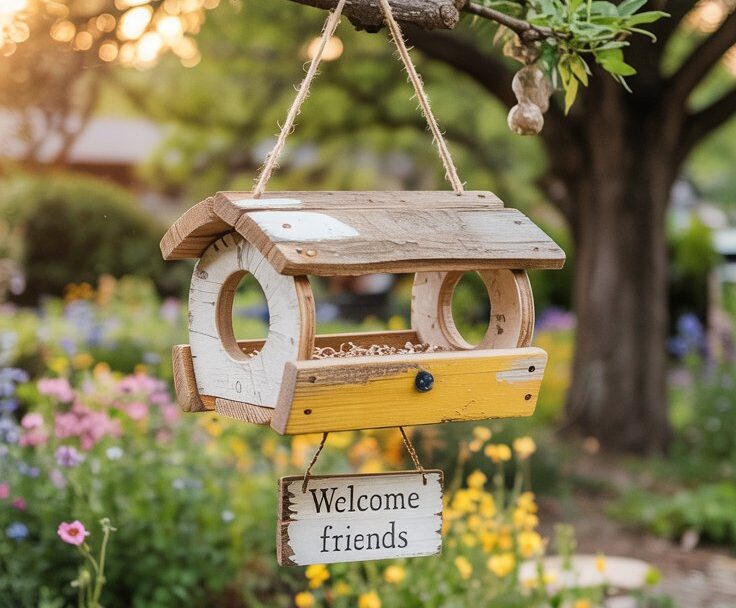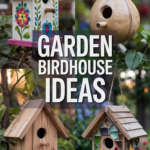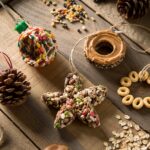Have you ever wanted to attract more birds to your yard but weren’t sure where to start? Building your own bird feeder can be a rewarding way to connect with nature while also providing essential food for your local bird population.
These five step-by-step bird feeder plans are designed to accommodate everyone from beginners to experienced woodworkers, making it easy for you to find a project that matches your skill level.
With the right plan, you’ll soon have birds flocking to your garden while enjoying the satisfaction of creating something with your own hands.
From simple recycled container feeders to more elaborate wooden designs, you’ll discover options that fit your available time, tools, and experience.
1) Basic Wooden Platform Feeder
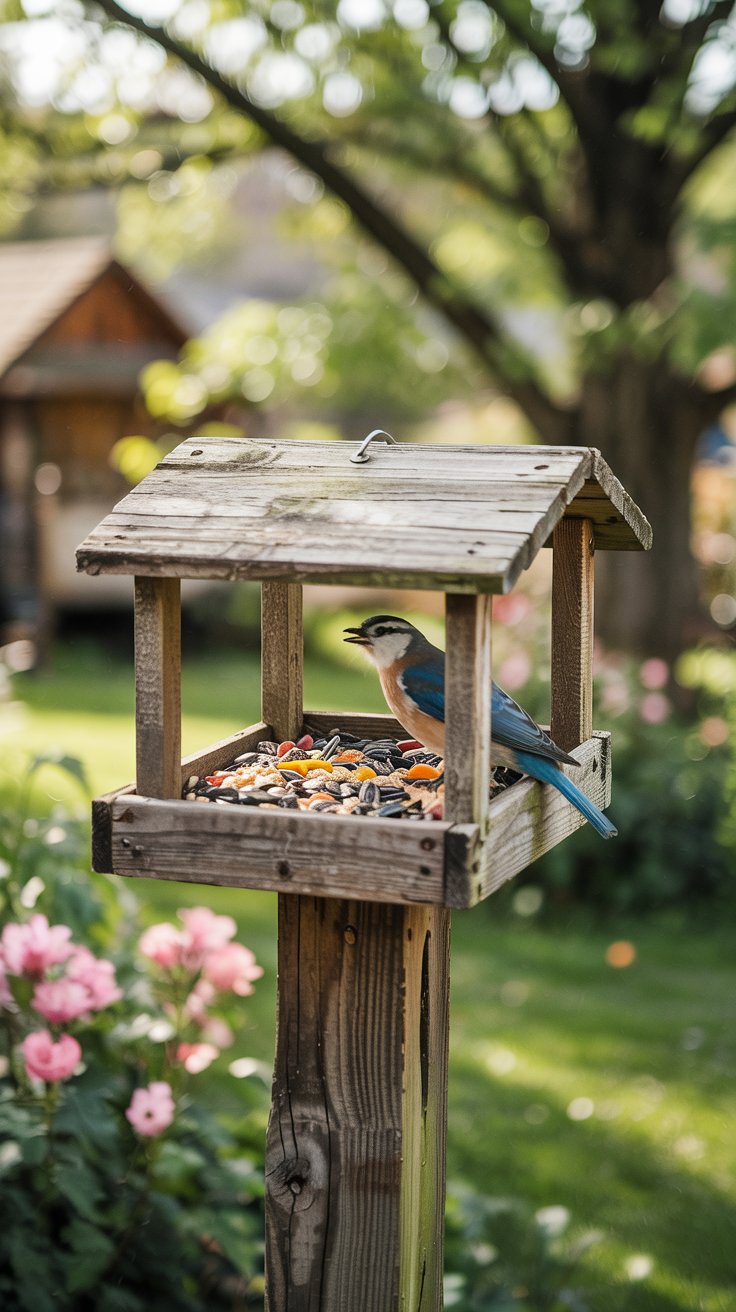
A platform feeder is one of the easiest bird feeders to build.
You’ll need a piece of weather-resistant wood about 12 inches square, four small pieces of wood for the rim, and four wooden dowels for legs.
- Cut your base board to size and sand all edges smooth. Birds can injure themselves on rough edges.
- Attach the rim pieces around the edges of your base. They should rise about 1/2 inch above the platform to keep seed from spilling out.
- Drill holes in each corner of your platform. Insert dowels to create legs that are about 8 inches long. You can adjust the height based on your preference.
- Apply a non-toxic, water-resistant sealer to protect the wood. Make sure it’s fully dry before putting out bird seed.
Platform feeders work well for attracting a variety of birds. Place your feeder at eye level for the best viewing experience.
If you don’t want to create legs for the platform feeder, you can skip this step. Instead, mount your platform feeder on a post, hang it from a branch, or place it on a railing. Just make sure it’s stable and won’t tip over.
Why we love it: Platform feeders attract the widest variety of birds, are super easy to clean, and let you watch birds up close without obstructions.
2) Easy DIY Bottle Feeder
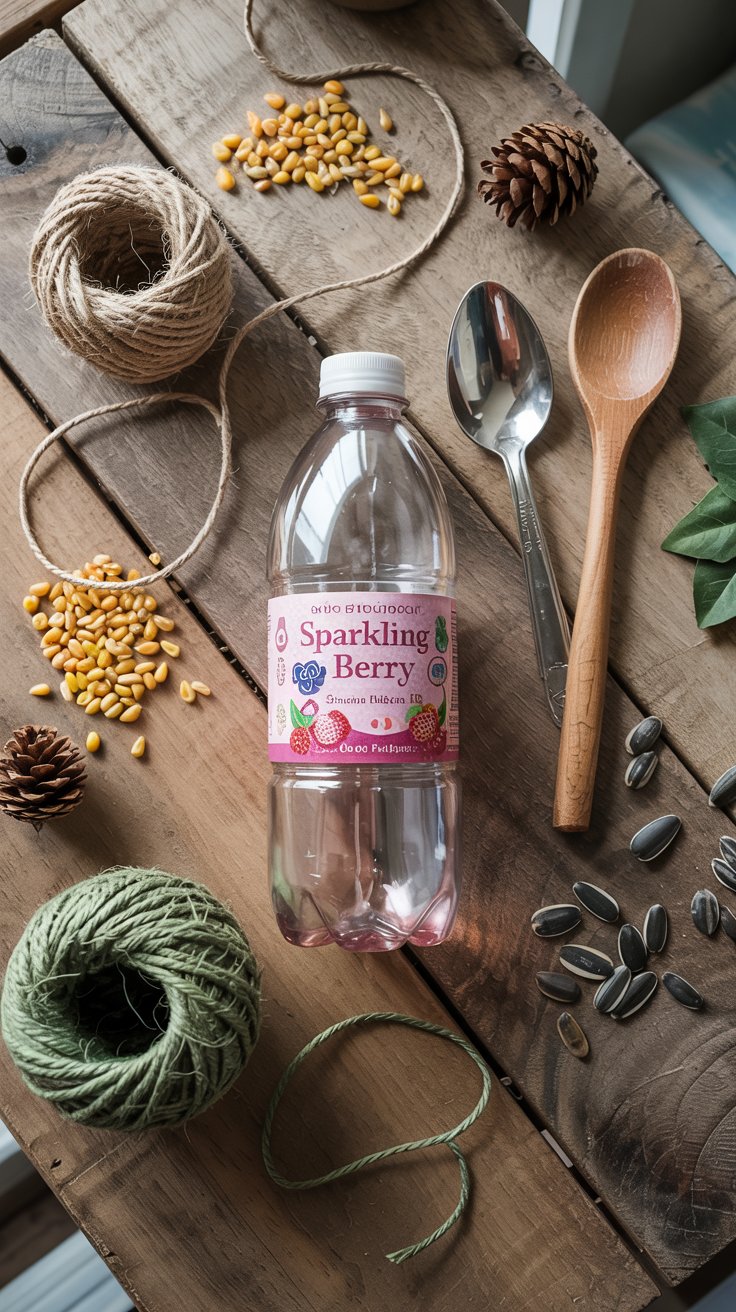
Making a bird feeder from a plastic bottle is perfect for beginners. You can create this simple feeder with items you already have at home.
You’ll need a clean plastic soda bottle, two wooden spoons, some string, and bird seed. This project takes less than 30 minutes to complete.
Here’s how to make it:
- Wash and dry a plastic bottle thoroughly.
- Cut two small holes opposite each other, about 2 inches from the bottom.
- Push wooden spoons through the holes, with handles sticking out as perches.
- Make a small hole about an inch above each perch for seed to flow out.
- Cut two small holes near the top and thread string through for hanging.
- Fill with birdseed and hang in a tree.
Soda bottle caps and bottoms make excellent small feeders too if you want to create multiple feeding stations.
Why we love it: This eco-friendly feeder recycles everyday materials, costs almost nothing to make, and lets you watch birds up-close while they enjoy their meal at your homemade creation.
3) Rustic Log Bird Feeder

Creating a rustic log bird feeder brings a natural woodland charm to your backyard. This project uses a hollowed-out log to create a unique feeding station for the birds.
You’ll need a fallen log about 12-16 inches long, basic tools like a drill, chisel, and sandpaper. Look for logs with interesting bark patterns or texture for added character.
- Start by hollowing out the center of your log to create a feeding trough. You can do this with a drill and chisel, working slowly to avoid splitting the wood.
- Add drainage holes at the bottom of your feeding area. Birds won’t visit if their food gets soggy!
- Install a roof overhang using bark or small wood pieces to protect seed from rain. Attach eye hooks to hang your feeder from a tree branch or pole.
- Apply a non-toxic sealant to weatherproof your feeder, avoiding the feeding area itself.
Why we love it: This rustic feeder blends beautifully with natural surroundings, requires minimal purchased materials, and each one turns out completely unique!
4) Window-Mounted Bird Feeder

A window-mounted bird feeder brings the joy of birdwatching right to your living room. These feeders attach directly to your window with strong suction cups, giving you an up-close view of the birds.
You don’t need advanced skills to set up this type of feeder. It’s perfect for beginners or those with limited outdoor space like apartments or condos.
Here’s how to build a simple window-mounted feeder:
- Gather materials: clear acrylic sheet, suction cups, wood for the base and sides, and screws
- Cut the acrylic to your desired size (typically 8″x10″)
- Build a simple wooden frame with a base
- Attach the suction cups to the acrylic
- Mount the finished feeder on a clean window
For the best results, place your feeder on a window that doesn’t get too much direct sunlight.
Birds may take a few days to discover your new feeder. Be patient and keep it filled with fresh seed.
Some window feeders even include a one-way mirror feature that lets you watch birds without them seeing you!
Why we love it: Window-mounted feeders bring nature incredibly close, perfect for photography and letting you enjoy birds even in bad weather from the comfort of your home.
5) Squirrel-Proof Bird Feeder
Building a squirrel-proof bird feeder will keep those pesky critters from stealing all your birdseed. This project is a little on the advanced side, so watch the video to see if it’s a good fit for your skill level.
This feeder uses a simple system that prevents squirrels from climbing down to the feeding area. It also prevents the larger birds from stealing all the bird seed.
Why we love it: This design frustrates squirrels while giving birds easy access to food for the smaller birds. You’ll also enjoy hours of entertainment watching the squirrels try to figure out how to reach the seed!
Tips for Beginners
Starting your bird feeding journey can be simple and rewarding with the right knowledge. These tips will help you create safe, effective feeders that attract a variety of beautiful birds to your backyard.
Understanding Bird Feeder Basics
When beginning your bird feeding adventure, focus on these fundamentals:
- Choose the right feeder type for your target birds. Options include platform, tube, hopper, and suet feeders.
- Position feeders correctly. Be sure to place them near cover, but not too close to bushes where predators can hide.
- Start with popular seeds like black oil sunflower seeds that attract many species.
- Keep feeders clean by washing them every two weeks with a mild bleach solution (1:10 ratio).
Bird feeders should be placed 10-12 feet from windows to prevent bird collisions. Start with one feeder type and expand as you learn which birds visit your yard.
Remember to be patient! It may take birds a few weeks to discover your new feeder.
Safe Materials to Use
Selecting bird-safe materials is crucial for their health and your feeder’s durability:
- Use untreated wood such as cedar, pine, or redwood. These work well and resist rot.
- Choose rust-proof hardware like stainless steel or galvanized screws and nails.
- Avoid toxic paints/stains. Instead, use water-based, non-toxic products specifically labeled as bird-safe.
- Include proper drainage to prevent seed spoilage.
Plastic containers like milk jugs can be repurposed for simple feeders, but replace them yearly as they degrade in sunlight. Clear plastic windows let you monitor seed levels easily.
Mesh materials should have appropriate-sized openings for your target birds and chosen seed types.
Choosing the Right Design
Selecting the perfect bird feeder depends on both the birds you want to attract and your local weather conditions. Your choice will determine which types of birds visit your yard and how well your feeder holds up over time.
Considerations for Different Bird Species
Different birds prefer different feeding styles. When choosing a feeder design, consider:
- Platform feeders are great for larger birds like cardinals and jays who need space to perch.
- Tube feeders are perfect for small birds like finches and chickadees.
- Hopper feeders are a versatile option that attracts a wide variety of birds.
- Nectar feeders are specifically designed for hummingbirds and orioles.
The seeds you use matter too! Black oil sunflower seeds attract many species, while nyjer seeds are perfect for finches. Match your feeder style with the right food for best results.
Weather and Climate Impact
Your local weather affects how well your feeder will perform and last. Consider these factors:
- Moisture resistance – Choose cedar, cypress, or treated pine for rainy climates
- Wind exposure – Heavier designs stay put in windy areas
- Snow accumulation – Select feeders with roofs in snowy regions
- Temperature fluctuations – Metal parts may be too hot in summer or freeze shut in winter
For year-round success, design birdfeeders with good drainage holes and removable parts for easy cleaning. By following some of these easy step-by-step bird feeder plans can help you build weather-appropriate options for your area.
